Weekly Current Affairs (8th to 14th July 2025) - 1 | Weekly Current Affairs - UPSC PDF Download
17th BRICS Summit
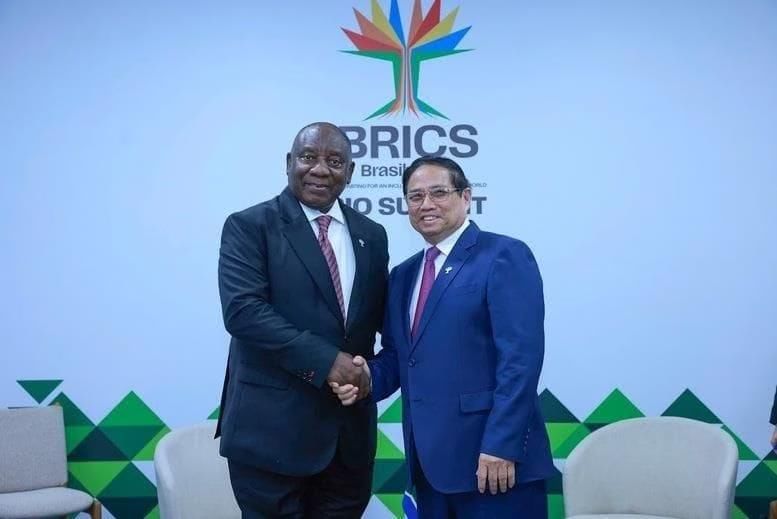 Why in News?
Why in News?
- The 17th BRICS Summit was held in Rio de Janeiro, Brazil, where India’s Prime Minister participated under the theme "Strengthening Global South Cooperation for More Inclusive and Sustainable Governance." During this summit, he signed the Rio de Janeiro Declaration. Additionally, Indonesia officially joined BRICS, while other countries such as Belarus, Bolivia, Kazakhstan, Cuba, Nigeria, Malaysia, Thailand, Vietnam, Uganda, and Uzbekistan were welcomed as BRICS partner countries. India is set to assume the BRICS Chairship and will host the 18th summit in 2026.
Key Takeaways
- BRICS supports reforms in global governance and advocates for an expanded UN Security Council.
- The summit addressed sustainable development with a focus on climate finance and carbon markets.
- Peace and security discussions included calls for a ceasefire in Gaza and reaffirmation of "African Solutions to African Problems."
- Financial cooperation initiatives aimed at reducing reliance on the US dollar were advanced.
- Health initiatives launched to address socially determined diseases.
Additional Details
- Global Governance Reform: BRICS advocated for expanding the UN Security Council to improve representation from Asia, Africa, and Latin America, and called for reforms in the IMF and World Bank.
- Sustainable Development: The Leaders’ Framework Declaration on Climate Finance was adopted to mobilize resources for developing countries, alongside an MoU on the BRICS Carbon Markets Partnership to enhance cooperation in carbon pricing and emissions trading.
- Financial Cooperation: Initiatives to reduce reliance on the US dollar were discussed, including the advancement of the New Development Bank and the BRICS Multilateral Guarantees (BMG) pilot project.
- Technology and Digital Economy: The summit concluded a statement on Global AI Governance and agreed to form a BRICS Space Council for collaborative space exploration.
- Condemnation of CBAM: BRICS nations rejected the Carbon Border Adjustment Mechanism (CBAM) proposed by the EU, arguing it hinders their transition to cleaner economies.
In summary, the 17th BRICS Summit highlighted the group's commitment to reforming global governance, promoting sustainable development, and enhancing financial cooperation among its members. The outcomes reflect a collective effort to strengthen the influence of emerging economies in international affairs.
India Becomes 4th ‘Most Equal’ Country Globally
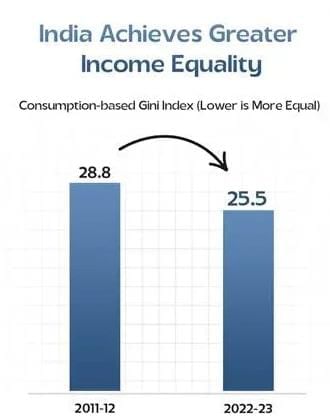
Why in News?
- India has achieved recognition not only as the world's fourth-largest economy but also as one of the most equal societies globally. According to the World Bank, India's Gini Index stands at 25.5, positioning it as the fourth most equal country worldwide.
Takeaways
- India's Gini Index of 25.5 reflects improved social equity.
- India ranks ahead of countries with higher inequality scores, such as China and the US.
- The low Gini score suggests broad-based income growth, particularly among lower-income groups.
Additional Details
- What is the Gini Index: The Gini index, or Gini coefficient, measures income inequality within a population. Developed by Italian statistician Corrado Gini in 1912, it derives its values from the Lorenz curve, which represents income distribution. The index ranges from 0 (perfect equality) to 1 (maximum inequality), with lower values indicating a more equitable society.
- India's Gini Index has improved from 28.8 in 2011 to 25.5 in 2022, indicating consistent progress in reducing inequality.
- India's score categorizes it under "moderately low inequality," contrasting with higher scores from developed nations.
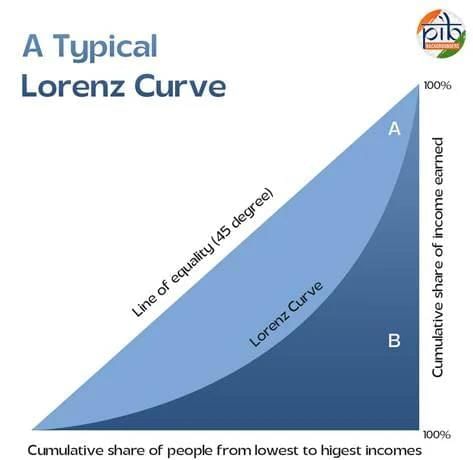
Significance for India
- India's ranking as more equal than G7 and G20 countries challenges the stereotype of it being a highly unequal society.
- The findings highlight broad-based income growth, especially in lower-income brackets.
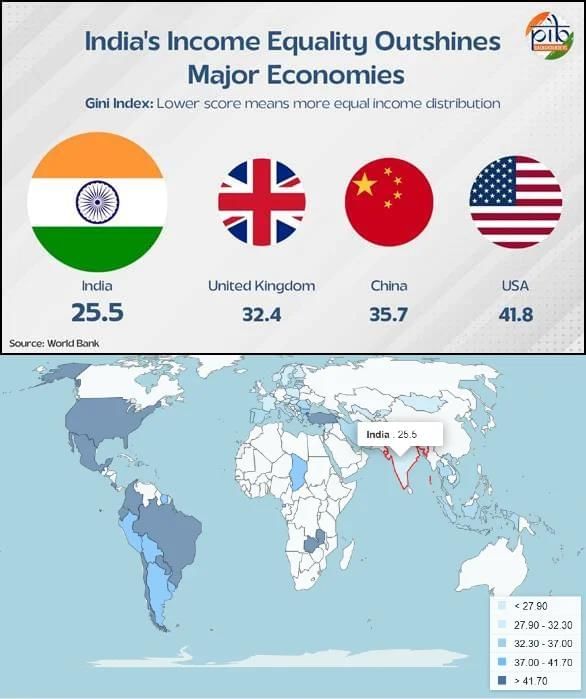
Key Drivers Behind India’s Equity Success
- Poverty Reduction: Since 2011, 171 million Indians have been lifted out of extreme poverty. The extreme poverty rate is now 5.3%, down from 27.1% in 2011.
- Welfare Schemes for Equity:
- PM Jan Dhan Yojana: Over 55.69 crore accounts opened for financial inclusion.
- Aadhaar and Digital Identity: Over 142 crore Aadhaar cards issued to streamline welfare delivery.
- Direct Benefit Transfer (DBT): Cumulative savings of Rs 3.48 lakh crore achieved through more efficient welfare payments.
- Ayushman Bharat: Health coverage provided for up to ₹5 lakh per family annually, with over 41.34 crore Ayushman Cards issued.
- Stand-Up India: More than 2.75 lakh applications sanctioned, promoting economic growth for disadvantaged communities.
- PMGKAY: Reached 80.67 crore beneficiaries with free food grains during crises.
- PM Vishwakarma Yojana: Over 29.95 lakh registrations to support traditional artisans.
Challenges and Structural Concerns Undermining India’s Equity Achievements
- High Poverty Despite Low Inequality Index: With a poverty rate of 28.1% in 2022, over 300 million people still live in poverty.
- Wage and Income Disparity: The top 10% earn significantly more than the bottom 10%, indicating persisting income inequality.
- Outdated Poverty Line: Reliance on an outdated poverty line hampers the effectiveness of welfare schemes.
- Unequal Access to Opportunities: Gaps in education, healthcare, and employment persist, especially among marginalized communities.
Way Forward
- Revise the National Poverty Line to reflect current economic conditions.
- Strengthen labor market protections to ensure fair wages and rights enforcement.
- Boost public investment in education and health to address inequality.
- Bridge the digital divide by enhancing access to technology.
- Implement measures to reduce gender inequality in opportunities.
In conclusion, India's Gini score of 25.5 signifies substantial progress in addressing inequality through comprehensive economic reforms and social protection initiatives. Programs like Jan Dhan, DBT, and Ayushman Bharat have enhanced access to essential services, while efforts like Stand-Up India and PM Vishwakarma Yojana promote self-reliance and inclusive growth.
Mains Question:
- India is ranked among the most equal nations globally. Examine the key policy measures and welfare schemes that have contributed to this achievement.
India’s First National Cooperative University
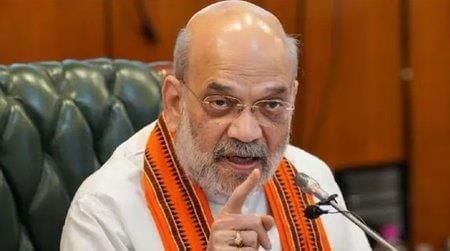 Why in News?
Why in News?
- The Union Home and Cooperation Minister has inaugurated the Tribhuvan Sahkari University in Anand, Gujarat, marking the establishment of India’s first national cooperative university. This initiative aligns with the government’s vision of ‘Sahkar se Samriddhi’ (Prosperity through Cooperation) aimed at strengthening the cooperative sector through education.
Key Takeaways
- The university is named after Tribhuvandas Kishibhai Patel, a pivotal figure in India's cooperative movement and founder of Amul.
- It aims to offer various educational programs including degree, diploma, and PhD courses in cooperative management and related fields.
- The university plans to train over 20 lakh professionals in five years across key sectors such as dairy, fisheries, and agricultural credit cooperatives.
Additional Details
- Tribhuvan Sahkari University (TSU): TSU is established to enhance the cooperative sector by focusing on education and skill development.
- Research and Development (R&D) Council: A dedicated council will be formed to promote innovation, transparency, and best practices in rural cooperative institutions.
- The cooperative sector consists of member-owned organizations that address common social and economic needs, fostering mutual assistance and resource sharing.
- The right to form cooperative societies is a Fundamental Right as per Article 19(1)(c) of the Constitution, established by the 97th Constitutional Amendment Act, 2011.
- The sector is primarily regulated by the Cooperative Societies Act, 1912, and the Multi-State Cooperative Societies (MSCS) Act, 2002, with recent amendments aimed at improving governance.
The establishment of Tribhuvan Sahkari University represents a significant step towards enhancing the cooperative sector in India through education, ultimately contributing to economic prosperity and social welfare.
India-Argentina Relations
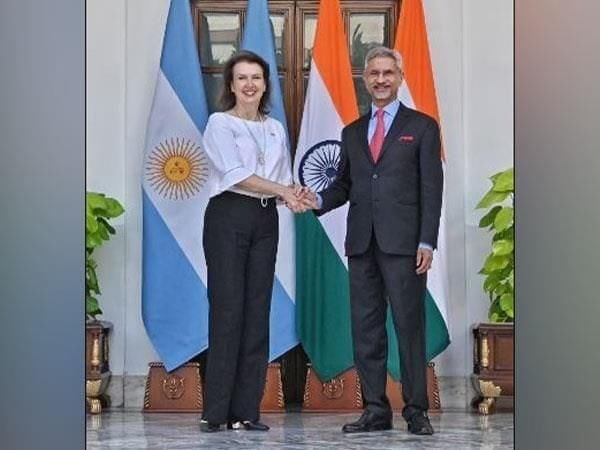 Why in News?
Why in News?
- The Prime Minister of India visited Argentina for the first time in 57 years, commemorating 75 years of diplomatic relations and 5 years of Strategic Partnership. During this visit, he was awarded the "Key to the City of Buenos Aires," which recognizes India's growing global prominence and the strengthening of bilateral ties.
Key Takeaways
- India and Argentina agreed to expand the India–MERCOSUR Preferential Trade Agreement (PTA) to enhance bilateral trade and economic relations.
- Both nations committed to collaboration in shale energy, leveraging Argentina's significant shale gas and oil reserves.
- There was an agreement to enhance defence manufacturing through co-development and technology transfer.
- Shared democratic values were reaffirmed, emphasizing South-South cooperation and multilateralism.
Additional Details
- Strategic and Economic Engagement: The focus is on trade diversification, reducing reliance on primary commodities, and enhancing investment in emerging sectors.
- Energy Security: India expressed interest in collaborating with Argentina's state-owned YPF in oil and gas sectors to meet its growing energy needs.
- Defence & Digital Cooperation: Expansion of India's Digital Public Infrastructure like UPI and telemedicine was discussed to strengthen tech partnerships.
- Shared Democratic Values: The visit to the statue of General San Martín symbolized the strong people-to-people ties and India's rising soft power in Latin America.
In conclusion, India-Argentina relations are evolving into a strategic and multidimensional partnership. With growing synergies in energy, digital technology, space, and trade, along with shared aspirations for the Global South, this relationship holds potential as a model for the 21st century.
Melting Glaciers Can Trigger Volcanic Eruptions
Why in News?
- A recent study presented at the 2025 Goldschmidt Conference in Prague has revealed a potential connection between the melting of glaciers and an uptick in volcanic activity, especially in areas like West Antarctica.
Key Takeaways
- Subglaciated volcanoes, located beneath glaciers and ice sheets, are sensitive to changes in glacial cover.
- Regions such as West Antarctica, Iceland, British Columbia, and parts of Russia and New Zealand are at risk as glaciers retreat.
Additional Details
- Subglaciated Volcanoes: These volcanoes are found under ice and glaciers. The melting of ice reduces the pressure that suppresses volcanic eruptions. In West Antarctica, around 100 volcanoes lie beneath ice, and as the ice diminishes, volcanic activity may increase over decades to centuries.
- Melting Ice and Volcanic Activity: Ice sheets exert pressure on underlying magma chambers, which helps keep eruptions at bay. When glaciers and ice caps melt, the decrease in pressure allows gases and magma to expand, heightening the chances of explosive eruptions. This phenomenon, termed glacial unloading, was initially proposed in the 1970s.
- Climate change can also lead to increased precipitation that interacts with magma systems, potentially triggering eruptions. For instance, during Iceland’s last major deglaciation (approximately 15,000 to 10,000 years ago), volcanic activity surged to 30-50 times higher than current levels.
In conclusion, the relationship between melting glaciers and volcanic eruptions underscores the complex interactions within Earth's systems, where climate change not only affects glacial dynamics but also has significant implications for volcanic activity and global climate patterns.
Five Pillars for a Sustainable India-Brazil Relations
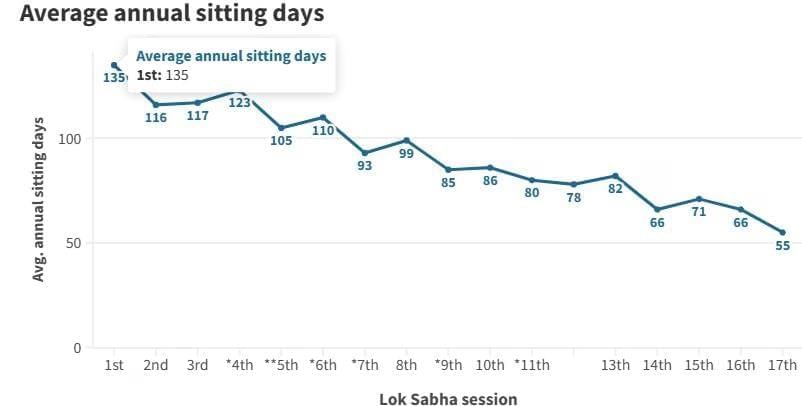 Why in News?
Why in News?
- India’s Prime Minister recently visited Brazil, where both nations reaffirmed their dedication to strengthening the India-Brazil Strategic Partnership established in 2006. They agreed to enhance bilateral relations focusing on five key priority areas. During the visit, India’s Prime Minister was honored with Brazil’s highest state accolade, the Grand Collar of the National Order of the Southern Cross.
Key Takeaways
- Defense and Security Cooperation
- Food & Agricultural Security
- Energy Transition & Climate Action
- Digital Transformation and Emerging Technologies
- Industrial Partnerships in Strategic Areas
Additional Details
- Defense and Security Cooperation: Agreements were signed on the Exchange and Mutual Protection of Classified Information, and on Combating International Terrorism and Transnational Organized Crime. A Cybersecurity Dialogue was also introduced for enhanced information sharing.
- Food & Agricultural Security: Both countries emphasized the necessity for actionable steps towards sustainable agriculture and food access, planning joint research and development in agricultural productivity, animal genetics, and biotechnology.
- Energy Transition & Climate Action: India and Brazil highlighted the significance of biofuels and the promotion of sustainable development, pledging to reinforce the Global Biofuels Alliance.
- Digital Transformation and Emerging Technologies: The nations agreed to convene the Joint Commission on Scientific and Technological Cooperation, focusing on pivotal areas like digital public infrastructure and renewable energy.
- Industrial Partnerships in Strategic Areas: Key sectors for collaboration include pharmaceuticals, mining, and oil & gas, with efforts to address non-tariff barriers and enhance private sector engagement.
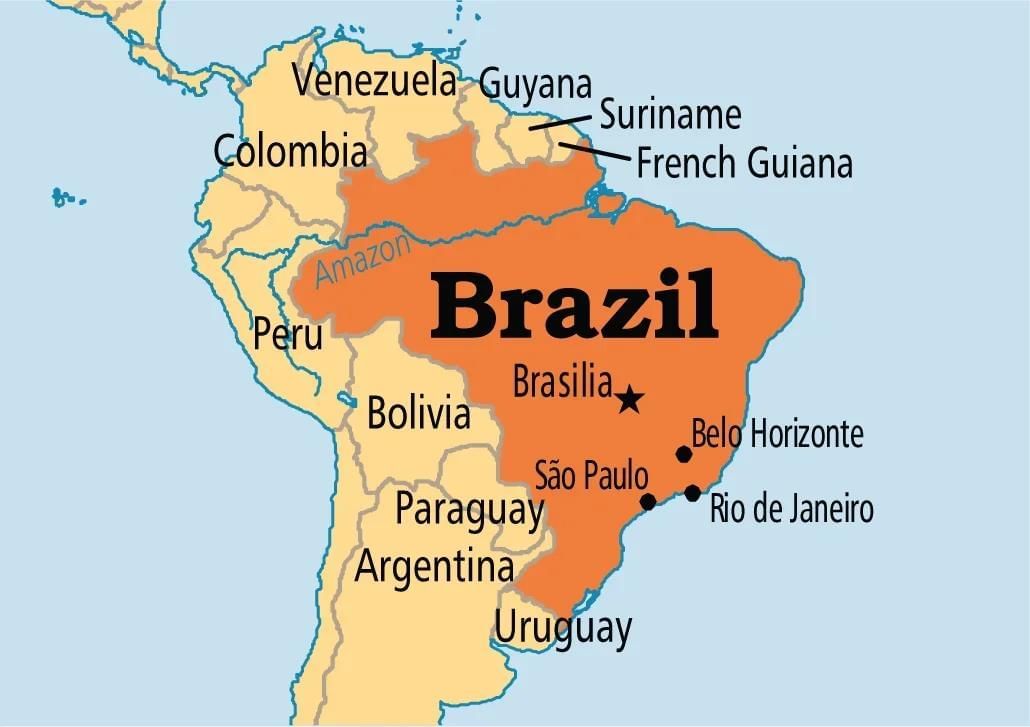
What are the Key Highlights of India-Brazil Relations?
- Political & Diplomatic Ties: Diplomatic relations initiated in 1948, with India maintaining an embassy in Brasília and a consulate in São Paulo.
- Trade & Economic Engagement: Bilateral trade reached USD 12.2 billion in 2024–25, with significant exports from India including petrochemicals and engineering goods.
- Defense & Security Cooperation: A 2003 Defense Cooperation Agreement led to a Joint Defence Committee and the 2+2 Political-Military Dialogue.
- Space & Technology Collaboration: India launched the Amazonia-1 satellite in 2021, and Brazil shows keen interest in India’s Digital Public Infrastructure.
- Cultural & People-to-People Ties: India opened its first cultural center in Latin America in São Paulo in 2011, fostering a vibrant Yoga and Ayurveda community.
What are the Challenges in India-Brazil Relations?
- Limited Economic Diversification: The current trade volume is modest and affected by stringent sanitary and phytosanitary regulations impacting agricultural trade.
- Geographical Distance: High transportation costs and connectivity issues reduce trade competitiveness.
- Competition in Agriculture & Biofuels: Rivalry in global sugar and ethanol markets poses challenges for collaboration.
- Cultural & Awareness Gaps: Limited cultural understanding hampers deeper ties, as both nations view each other through narrow perspectives.
- Diverging Global Priorities: Differing regional focuses complicate multilateral alignments, especially regarding climate negotiations.
In What Ways can India-Brazil Relations be Strengthened Further?
- Boost Trade & Economic Engagement: Aim for a bilateral trade target of USD 20 billion in the next five years by diversifying trade commodities.
- Improve Logistics & Connectivity: Establish an India-Brazil maritime corridor to reduce shipping costs and enhance connectivity.
- Enhance Energy & Green Partnerships: Collaborate on biofuels and ethanol, scaling up projects under the Global Biofuels Alliance.
- Deepen Agricultural & Food Security Ties: Work together on developing GM crops and joint ventures in organic food production.
- Strengthen Institutional Mechanisms: Hold annual high-level summits to promote state-level partnerships and advance diplomatic engagements.
The strategic partnership between Brazil and India, anchored on five key pillars, presents significant opportunities despite existing challenges. By enhancing economic ties and aligning global priorities, both nations can emerge as vital leaders in the Global South, fostering mutual growth in an increasingly multipolar world.
Mains Question:
- "India and Brazil share a strategic partnership, yet bilateral trade remains below potential." Discuss the challenges and suggest measures to enhance economic engagement.
India-Namibia Relations
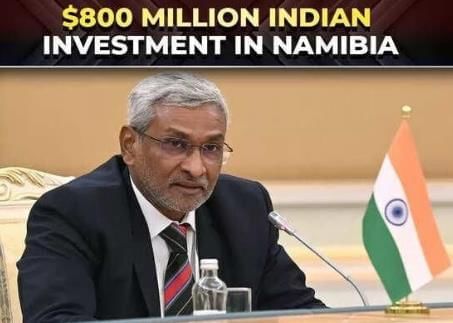
Why in News?
- India's Prime Minister recently made a State Visit to Namibia, marking the first visit by an Indian Prime Minister in 27 years. During this visit, he addressed the Namibian Parliament and reaffirmed India's commitment to fostering a partnership based on dialogue rather than dominance. He was awarded Namibia's highest civilian honor—the Order of the Most Ancient Welwitschia Mirabilis—making him the first Indian leader to receive this accolade. Additionally, Namibia submitted letters of acceptance to join the Coalition for Disaster Resilient Infrastructure (CDRI) and the Global Biofuels Alliance, becoming the first country globally to sign a licensing agreement for adopting UPI technology.
Key Takeaways
- Historical ties with significant diplomatic support since Namibia's independence.
- Successful Cheetah Translocation Project, marking the first intercontinental translocation of a major carnivore species.
- Active defense cooperation and capacity-building initiatives, including scholarships and defense training.
- Development assistance, including COVID-19 vaccine doses and establishment of educational centers.
- Growing economic relations with bilateral trade reaching USD 568.40 million in 2024-25.
Additional Details
- Historical and Political Ties: India was among the first countries to advocate for Namibia's independence at the United Nations in 1946, providing support to SWAPO during its liberation struggle. Full diplomatic relations were established in 1990, and Namibia opened its resident mission in New Delhi in March 1994.
- Cheetah Translocation Project: In 2022, eight cheetahs were translocated from Namibia to India, representing a significant conservation effort.
- Economic Relations: Bilateral trade includes key sectors such as mining, energy, agriculture, education, and healthcare. A Preferential Trade Agreement (PTA) is currently under negotiation with the Southern African Customs Union (SACU).
- Indian Community: Approximately 450 Indians/NRIs/PIOs reside in Namibia, supported by organizations like the India-Namibia Chamber of Commerce and Industry.
The relationship between India and Namibia showcases a strong foundation built on historical solidarity, strategic cooperation, and shared development goals. Strategic recalibration is necessary for India to address investment gaps and deepen engagement with African nations.
Africa's Strategic Importance to India
Why is Africa Strategically Important to India?
- Africa's geopolitical position is crucial for India's maritime trade routes and naval influence. The continent's economic potential is rising, with bilateral trade between India and Africa reaching USD 98 billion in 2022-23. The African Continental Free Trade Area (AfCFTA) further enhances trade opportunities for India.
Key Takeaways
- Geopolitical and maritime safeguards are critical for securing trade routes.
- Rising economic power with significant bilateral trade and investment opportunities.
- Access to critical minerals essential for renewable energy and technology.
- Diplomatic leverage through Africa's global economic role and support in international forums.
- A strong Indian diaspora in Africa enhances bilateral ties and economic engagement.
Additional Details
- Geopolitical Safeguards: Africa serves as a vital link in securing maritime routes essential for trade, with strategic initiatives like establishing a naval base in Mauritius.
- Securing Critical Minerals: Countries like the Democratic Republic of Congo are significant suppliers of cobalt, vital for electric vehicle batteries.
- Diplomatic Challenges: India's engagement with Africa has faced criticism for focusing predominantly on East and Southern Africa, risking under-engagement with other regions.
- Resource Competition: India faces competition from China for access to African resources, leading to complex diplomatic situations.
To deepen its engagement with Africa, India must address investment challenges, enhance diplomatic outreach, and promote innovation-driven partnerships that foster mutual growth and development.
World Bioproduct Day 2025
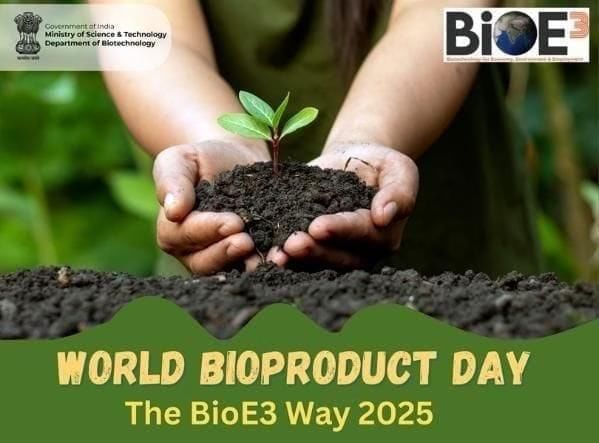 Why in News?
Why in News?
- The Department of Science & Technology (DST), in collaboration with BIRAC and iBRIC+, has organized World Bioproduct Day 2025. This event emphasizes the themes of Equity, Environment, and Economy, underscoring the critical role of public participation in biotechnology. It also reiterated the government's ambition to achieve a USD 300 billion bioeconomy by 2030 under the BioE3 framework.
Key Takeaways
- The event focuses on inclusive participation in biotechnology.
- It aims to promote a sustainable bioeconomy by 2030.
What are Bioproducts?
- Definition: Bioproducts refer to fuels, materials, and chemicals derived from renewable biomass sources such as crops, trees, algae, and agricultural waste.
- Examples:
- Biofuels (e.g., ethanol, biogas)
- Bioplastics
- Bio-based cosmetics
- Plant-derived medicines
- Significance: Bioproducts help reduce reliance on fossil fuels, addressing issues like air pollution, deforestation, and biodiversity loss. They promote climate-resilient development while maintaining product quality.
Categories of Bioproducts
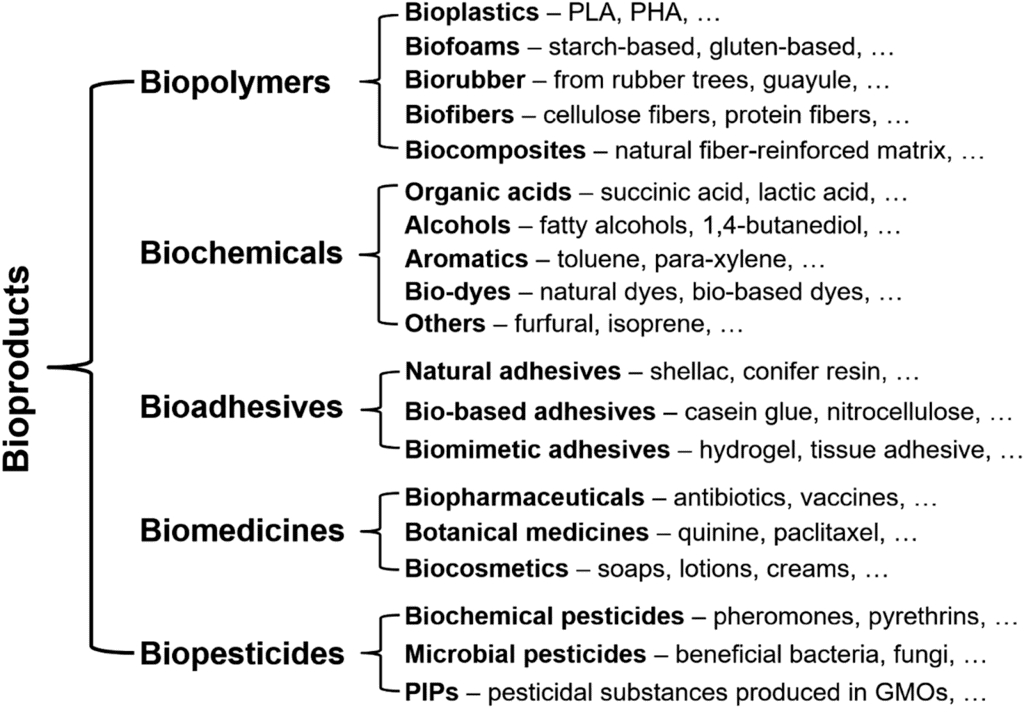
Production Methods
- Bioproducts are manufactured through various methods, including:
- Fermentation
- Pyrolysis
- Enzymatic conversion
- Chemical synthesis
- Biodegradability: Not all bioproducts are biodegradable; it varies based on their intended application (e.g., bio-based paint may not be biodegradable).
Feedstocks & Sustainability
- Common Feedstocks: Sources include soybeans, corn, sugarcane, sunflowers, flax, potatoes, algae, and mycelium.
- Many bioproducts utilize agricultural or forestry waste, which helps minimize the pressure on food supplies. For instance, sunflower residue can be converted into biofuel.
What is the BioE3 Policy?
The BioE3 Policy, which stands for Biotechnology for Economy, Environment, and Employment, was launched by the Department of Biotechnology in 2024. Its primary goal is to promote high-performance biomanufacturing by integrating advanced biotechnological processes across various key sectors.
Key Features
- Biomanufacturing Infrastructure: The policy aims to enhance research and development (R&D), foster entrepreneurship, and establish Biomanufacturing & Bio-AI hubs.
- Supports Sustainable Biomanufacturing: Aligned with the 'Lifestyle for Environment' (LiFE) initiative, the policy encourages the creation of regenerative bioeconomy models that are sustainable and resource-efficient. It also emphasizes ethical biosafety and global regulatory standards to enhance India's competitiveness in biotechnology.
- Workforce Expansion: Focuses on building a skilled biotechnology workforce, particularly in Tier-II and Tier-III cities, to generate new employment opportunities and drive regional growth.
Core Themes of BioE3 Policy
- Bio-Based Chemicals & Enzymes: Promotes eco-friendly alternatives to petrochemicals.
- Functional Foods & Smart Proteins: Aims to develop nutrient-rich and sustainable food sources.
- Precision Biotherapeutics: Focuses on advancing targeted medical treatments and diagnostics.
- Climate-Resilient Agriculture: Supports agricultural methods adapted to climate change.
- Carbon Capture & Utilization (CCU): Encourages technologies for capturing and reusing carbon.
- Futuristic Marine & Space Research: Explores marine and space biotechnology for innovative solutions in biomanufacturing.
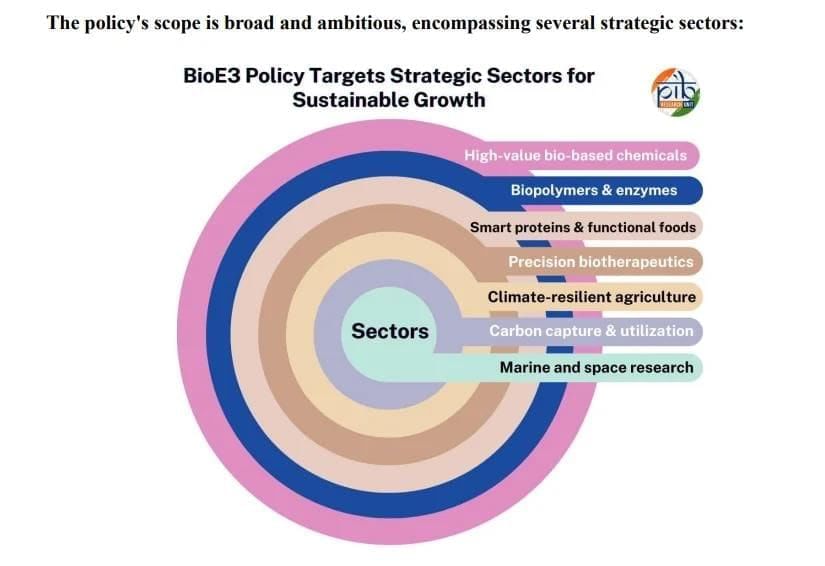
In conclusion, World Bioproduct Day 2025 and the BioE3 Policy play significant roles in advancing biotechnology, promoting sustainable practices, and fostering economic growth through innovation.
|
288 docs|142 tests
|
FAQs on Weekly Current Affairs (8th to 14th July 2025) - 1 - Weekly Current Affairs - UPSC
| 1. What are the main outcomes of the 17th BRICS Summit? |  |
| 2. How has India achieved the status of the 4th 'Most Equal' country globally? |  |
| 3. What is the significance of India's First National Cooperative University? |  |
| 4. What are the key aspects of India-Argentina relations? |  |
| 5. What is the BioE3 Policy and its objectives? |  |





















